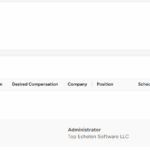Agency recruiters and search consultants are constantly challenged to navigate a complex terrain while striving to deliver exceptional results. The digital age has ushered in a plethora of tools and technologies aimed at streamlining recruitment processes and enhancing efficiency. Among these tools, the applicant tracking system (ATS) stands out as a cornerstone for managing the intricacies of talent acquisition. However, the true power of an ATS lies not just in its implementation, but in how effectively it is utilized, particularly in terms of activity tracking.
In this comprehensive blog post, we will examine the significance of activity tracking within an ATS. We’ll also explore its transformative impact on productivity, accountability, and success for agency recruiters and search consultants.
Understanding the Essence of Activity Tracking
Activity tracking within an applicant tracking system involves the systematic recording and monitoring of various recruitment-related actions and engagements. These activities encompass a broad spectrum of interactions, from initial candidate outreach to final placement negotiations.
Each touchpoint represents a critical step in the recruitment journey, contributing to the overall progress and success of placements.
Key Components of Activity Tracking
There are multiple key components of activity tracking within an ATS platform. In fact, there are even more than just a few.
Below, I have listed these key components, along with a description and explanation for each one:
Candidate Engagement
Candidate engagement serves as the cornerstone of the recruitment process. It encompasses all interactions between recruiters and potential candidates, spanning from the initial outreach to the final offer stage. Meticulously logging these engagements within the ATS provides recruiters with valuable insights into the candidate’s journey, enabling them to tailor their approach and provide personalized support throughout the recruitment lifecycle.
Initial Outreach
The first point of contact with a candidate sets the tone for the entire recruitment process. Whether it’s through email, social media, or networking events, recruiters must document each outreach attempt and track the response rate to gauge the effectiveness of their communication strategy.
Screening Calls
Screening calls are a crucial step in assessing a candidate’s qualifications and suitability for a role. Recording details such as the date, time, and outcome of each screening call allows recruiters to track candidate progress and ensure continuity in the evaluation process.
Interviews
Whether conducted in-person, via video conference, or over the phone, interviews provide recruiters with valuable insights into a candidate’s skills, experience, and cultural fit. Logging interview details, including questions asked, candidate responses, and interviewer feedback, facilitates informed decision-making and ensures consistency in candidate evaluation.
Follow-ups
Following up with candidates after interviews or assessments demonstrates professionalism and keeps the lines of communication open. Recording follow-up actions and scheduling future touchpoints within the ATS helps recruiters maintain momentum in the recruitment process and provides candidates with a positive experience.
Client Communication
Effective communication with clients is essential for understanding their needs, aligning expectations, and ultimately securing placements. By recording client interactions within the ATS, recruiters ensure transparency, accountability, and a holistic view of client relationships. This comprehensive approach fosters trust and strengthens partnerships with clients, enhancing the overall recruitment experience.
Requirement Gathering
Understanding the client’s hiring needs and expectations is paramount to delivering quality candidates. Documenting detailed job requirements, including desired skills, qualifications, and cultural fit, within the ATS ensures alignment between recruiters and clients from the outset.
Candidate Presentations
Presenting candidates to clients involves careful preparation and communication. Recording candidate profiles, feedback from client interviews, and any additional requirements or preferences within the ATS enables recruiters to track client preferences and tailor their candidate presentations accordingly.
Feedback and Updates
Providing timely updates and soliciting feedback from clients throughout the recruitment process is crucial for maintaining transparency and trust. Logging client feedback, preferences, and any changes to job requirements within the ATS facilitates clear communication and ensures alignment between recruiters and clients.
Sourcing Efforts
Sourcing the right candidates is a fundamental aspect of recruitment success. Tracking sourcing activities within the ATS allows recruiters to evaluate the effectiveness of their strategies and channels. Whether it’s posting job ads, leveraging social media, or implementing referral programs, understanding which methods yield the best results enables recruiters to refine their approach and attract top talent more efficiently.
Job Postings
Posting job ads on various job boards, company websites, and social media platforms is a common method for attracting candidates. Recording details such as the job title, description, posting date, and platform used within the ATS enables recruiters to track the performance of each job posting and adjust their strategy accordingly.
Social Media Outreach
Leveraging social media platforms such as LinkedIn, Twitter, and Facebook to engage with potential candidates can yield valuable leads. Tracking social media outreach efforts, including connection requests, messages sent, and responses received, provides recruiters with insights into the effectiveness of their social recruiting strategy.
Referral Programs
Employee referral programs are a cost-effective way to source qualified candidates through existing networks. Documenting referrals received, candidate referrals submitted, and successful placements made within the ATS allows recruiters to measure the impact of their referral program and reward employees for their contributions.
Interviews and Assessments
The interview and assessment stage is where candidates are evaluated for their suitability and fit for specific roles. Logging each stage of this process, from scheduling interviews to collecting feedback and evaluations, ensures consistency, compliance, and informed decision-making. By centralizing this information within the ATS, recruiters can streamline their workflow, expedite the hiring process, and deliver an exceptional candidate experience.
Interview Scheduling
Coordinating interview schedules can be a time-consuming process involving multiple stakeholders. Logging details such as interview dates, times, locations, and participants within the ATS streamlines the scheduling process and ensures that all parties are well-informed and prepared.
Candidate Evaluations
Collecting feedback and evaluations from interviewers provides valuable insights into a candidate’s strengths, weaknesses, and overall fit for the role. Standardizing evaluation criteria, capturing interviewer ratings, and documenting specific feedback within the ATS facilitates objective decision-making and minimizes bias in the selection process.
Assessment Results
Administering skills assessments or psychometric tests can help recruiters assess a candidate’s technical proficiency, cognitive abilities, and personality traits. Recording assessment results, scores, and any additional observations within the ATS enables recruiters to make data-driven hiring decisions and ensure alignment with client requirements.
The Transformative Impact of Activity Tracking
Beyond the basic function of record-keeping, activity tracking within an ATS has a profound impact on recruitment operations and outcomes. When implemented effectively, activity tracking serves as a catalyst for enhanced productivity, improved accountability, data-driven decision-making, streamlined collaboration, and a superior candidate experience.
1. Enhanced Productivity
A well-structured activity tracking system enables recruiters to optimize their workflow and prioritize tasks effectively. By providing visibility into pending actions, deadlines, and key metrics, recruiters can avoid bottlenecks, minimize administrative overhead, and focus their efforts on high-impact activities. This results in a more efficient recruitment process and faster time-to-fill rates.
Task Prioritization: Prioritizing tasks based on their urgency and importance ensures that recruiters allocate their time and resources effectively. Utilizing task management features within the ATS, recruiters can categorize tasks, set deadlines, and track progress to ensure that critical activities are completed on time.
Time Management: Time is a precious resource in recruitment, and effective time management is essential for maximizing productivity. Recording time spent on various recruitment activities, such as candidate sourcing, client meetings, and interview preparation, within the ATS provides insights into time allocation and helps recruiters identify opportunities for optimization.
Pipeline Management: Managing multiple candidates and job requisitions simultaneously requires careful organization and oversight. Maintaining a clear overview of the recruitment pipeline, including candidate statuses, stage transitions, and next steps, within the ATS allows recruiters to identify bottlenecks, prioritize tasks, and maintain momentum throughout the hiring process.
2. Improved Accountability
Activity tracking fosters a culture of accountability within recruitment teams by providing transparency and visibility into individual and collective performance. Real-time data on key metrics such as candidate outreach, client engagement, and time-to-fill empower recruiters to set and monitor targets, hold themselves accountable for meeting objectives, and drive continuous improvement.
Performance Metrics: Establishing performance metrics and targets for recruiters encourages accountability and goal alignment. By tracking metrics such as candidate submissions, client interviews, and placements made within the ATS, recruiters can measure their progress against predefined benchmarks and take corrective action as needed.
Goal Setting: Setting SMART (Specific, Measurable, Achievable, Relevant, Time-bound) goals ensures that recruiters have clear objectives to work towards. Documenting individual and team goals within the ATS, along with action plans and timelines, provides a roadmap for success and fosters accountability for results.
Performance Reviews: Conducting regular performance reviews allows recruiters to reflect on their achievements, identify areas for improvement, and receive feedback from peers and managers. Leveraging performance data stored within the ATS, recruiters can track their progress over time, identify trends, and make adjustments to their approach to optimize performance.
3. Data-Driven Decision Making
The data captured through activity tracking serves as a valuable resource for informed decision-making. By analyzing historical trends, identifying patterns, and measuring the efficacy of recruitment strategies, recruiters can make data-driven decisions to optimize processes, allocate resources efficiently, and stay ahead of the competition. This strategic approach enhances the effectiveness of recruitment efforts and yields better outcomes.
Performance Analytics: Leveraging analytics and reporting tools within the ATS enables recruiters to gain insights into key performance metrics and trends. By analyzing data on candidate sourcing, engagement rates, time-to-fill, and placement success, recruiters can identify areas of strength and opportunities for improvement, leading to more effective recruitment strategies.
Trend Analysis: Identifying trends and patterns in recruitment data allows recruiters to anticipate market shifts, adjust their approach, and stay ahead of the competition. By monitoring factors such as candidate preferences, job market dynamics, and industry trends within the ATS, recruiters can proactively adapt their sourcing strategies and candidate outreach efforts to capitalize on emerging opportunities.
Predictive Analytics: Harnessing the power of predictive analytics enables recruiters to forecast future hiring needs, identify potential talent gaps, and develop proactive recruitment strategies. By analyzing historical data on candidate engagement, hiring trends, and workforce demographics within the ATS, recruiters can anticipate future demand, optimize resource allocation, and align recruitment efforts with business objectives.
4. Streamlined Collaboration
Activity tracking facilitates seamless collaboration and knowledge sharing among team members. With a centralized repository of recruitment activities and candidate profiles, recruiters can collaborate more effectively, share insights, and leverage collective expertise to identify the best-fit candidates for each role. This collaborative approach fosters innovation, improves decision-making, and accelerates the hiring process.
Team Collaboration: Collaboration among recruiters, sourcers, and hiring managers is essential for success in recruitment. Utilizing collaboration features within the ATS, such as shared candidate profiles, communication threads, and collaborative workflows, fosters teamwork and ensures alignment throughout the recruitment process.
Knowledge Sharing: Sharing best practices, insights, and candidate feedback among team members promotes continuous learning and improvement. By documenting successful strategies, lessons learned, and candidate preferences within the ATS, recruiters can leverage collective expertise and avoid reinventing the wheel.
Cross-Functional Integration: Integrating the ATS with other systems and tools used across the organization enhances collaboration and streamlines processes. Whether it’s integrating with HRIS systems for seamless onboarding or syncing with email and calendar applications for scheduling interviews, interoperability between systems ensures data consistency and eliminates redundant tasks.
5. Enhanced Candidate Experience
A well-structured activity tracking system ensures that candidates receive timely and personalized communication throughout the recruitment journey. By keeping candidates informed about the status of their application, scheduling interviews promptly, and providing constructive feedback, recruiters can enhance the candidate experience and strengthen their employer brand. This positive experience not only attracts top talent but also fosters long-term relationships with candidates, leading to increased referrals and repeat business.
Communication Transparency: Maintaining open and transparent communication with candidates is essential for building trust and rapport. Utilizing communication templates, automated notifications, and personalized messages within the ATS ensures that candidates receive timely updates and feedback at every stage of the recruitment process.
Candidate Feedback: Soliciting feedback from candidates provides valuable insights into their experience and perceptions of the recruitment process. Incorporating feedback surveys, satisfaction ratings, and candidate testimonials within the ATS enables recruiters to gather feedback systematically, identify areas for improvement, and continuously enhance the candidate experience.
Talent Community Engagement: Building and nurturing a talent community allows recruiters to cultivate relationships with passive candidates and stay connected with talent pools for future opportunities. Leveraging talent community features within the ATS, such as talent pipelines, talent networks, and automated nurture campaigns, enables recruiters to engage with candidates proactively and maintain a strong talent pipeline.
Best Practices for Effective Activity Tracking
While the benefits of activity tracking are evident, maximizing its effectiveness requires adherence to best practices and a strategic approach to implementation. Here are some key considerations for optimizing activity tracking within an applicant tracking system:
Standardize Data Entry
Establish clear guidelines and protocols for recording recruitment activities to ensure consistency and accuracy across the board. Consistent data entry practices facilitate meaningful analysis, reporting, and decision-making, enhancing the overall effectiveness of activity tracking efforts.
Data Integrity
Ensuring data integrity and accuracy is paramount for making informed decisions and maintaining credibility. Implementing validation rules, data quality checks, and user permissions within the ATS helps prevent errors, duplicates, and inconsistencies in data entry.
Compliance
Maintaining compliance with data protection regulations, such as GDPR and CCPA, is essential for protecting candidate privacy and safeguarding sensitive information. Implementing data retention policies, access controls, and encryption measures within the ATS ensures compliance with regulatory requirements and mitigates the risk of data breaches.
Utilize Automation
Leverage automation features within the ATS to streamline repetitive tasks, such as email communications, interview scheduling, and candidate follow-ups. Automation not only saves time and reduces manual effort but also ensures consistency and compliance with established processes.
Email Automation/
Automating email communications, such as candidate status updates, interview reminders, and rejection notifications, improves efficiency and ensures timely communication with candidates. Utilizing email templates, merge tags, and scheduling features within the ATS enables recruiters to personalize messages and maintain consistent communication throughout the recruitment process.
Workflow Automation
Automating workflow tasks, such as candidate screening, application routing, and interview scheduling, accelerates the hiring process and reduces administrative overhead. Configuring workflow rules, triggers, and approvals within the ATS streamlines process execution and ensures adherence to predefined workflows and protocols.
Implement Customizable Dashboards
Configure customizable dashboards and reporting tools to track key performance metrics, monitor progress towards targets, and identify areas for improvement. Customizable dashboards empower recruiters to visualize data in meaningful ways, gain actionable insights, and make informed decisions to drive performance.
Performance Metrics
Designing dashboards to display performance metrics, such as candidate pipeline metrics, time-to-fill trends, and conversion rates, enables recruiters to track progress and measure success against predefined targets. Utilizing interactive charts, graphs, and filters within the ATS dashboard provides real-time visibility into recruitment KPIs and facilitates data-driven decision-making.
Pipeline Analytics
Analyzing pipeline metrics, such as candidate flow, stage conversion rates, and pipeline velocity, helps recruiters identify bottlenecks and optimize the recruitment process. Visualizing pipeline data using funnel charts, cohort analysis, and trend graphs within the ATS dashboard enables recruiters to pinpoint areas for improvement and implement targeted interventions to accelerate hiring.
User Performance
Monitoring user performance metrics, such as activity levels, engagement rates, and conversion metrics, allows recruiters to assess individual and team performance. Creating personalized dashboards for recruiters, managers, and stakeholders within the ATS dashboard enables stakeholders to track progress, identify coaching opportunities, and drive accountability for results.
Promote Training and Adoption
Provide comprehensive training and ongoing support to recruiters and team members to ensure full utilization of the ATS and adherence to activity tracking protocols. Training programs should cover system functionality, data entry best practices, and the importance of activity tracking in achieving recruitment objectives.
Onboarding
Conducting thorough onboarding sessions for new hires ensures that recruiters are equipped with the knowledge and skills required to use the ATS effectively. Providing hands-on training, video tutorials, and job aids tailored to different user roles and proficiency levels accelerates the learning curve and promotes early adoption of the ATS.
Continuous Learning
Offering ongoing training and professional development opportunities keeps recruiters up-to-date on the latest features and best practices for using the ATS. Hosting regular training webinars, lunch-and-learn sessions, and knowledge-sharing forums within the ATS encourages continuous learning and fosters a culture of innovation and improvement.
User Support
Providing responsive user support and troubleshooting assistance ensures that recruiters have the resources they need to overcome challenges and maximize their productivity. Establishing a dedicated support team, helpdesk portal, and knowledge base within the ATS enables recruiters to access self-service resources and seek assistance from experts when needed.
Regularly Review and Refine Processes
Continuously evaluate the effectiveness of activity tracking processes, solicit feedback from users, and make iterative improvements to optimize performance over time. Regular reviews enable recruiters to identify bottlenecks, address pain points, and implement enhancements to streamline operations and drive better outcomes.
Process Audits
Conducting periodic audits of activity tracking processes and data quality helps identify areas for improvement and ensure compliance with best practices. Utilizing audit reports, data validation tools, and quality assurance checks within the ATS facilitates process optimization and enhances the reliability of recruitment data.
User Feedback
Soliciting feedback from users on their experience with the ATS and activity tracking workflows provides valuable insights into usability issues, pain points, and feature requests. Implementing feedback mechanisms, such as surveys, focus groups, and user forums within the ATS, enables recruiters to gather input from stakeholders and drive continuous improvement initiatives.
Continuous Improvement
Establishing a culture of continuous improvement encourages experimentation, innovation, and adaptation to changing needs and priorities. Implementing agile methodologies, iterative development cycles, and user-driven enhancements within the ATS fosters a culture of collaboration and empowers recruiters to drive meaningful change and deliver exceptional results.
In the competitive landscape of recruitment, the effective utilization of technology is essential for maximizing efficiency, fostering accountability, and driving success. Activity tracking within an Applicant Tracking System serves as a linchpin for achieving these objectives, providing a systematic framework for recording and monitoring recruitment activities.
By embracing best practices, leveraging technology, and prioritizing the diligent tracking of interactions and engagements, agency recruiters and search consultants can unlock the full potential of their ATS and elevate their recruitment efforts to new heights. In doing so, they can not only streamline operations and enhance productivity but also deliver exceptional value to clients and candidates alike, solidifying their position as trusted partners in the talent acquisition process.
Through strategic implementation and continuous improvement, activity tracking becomes not just a tool but a catalyst for excellence in recruitment. By embracing the transformative power of activity tracking within their ATS, agency recruiters and search consultants can drive tangible results, foster collaboration, and deliver exceptional experiences that set them apart in a competitive market!









